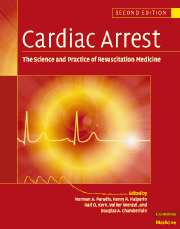Book contents
- Frontmatter
- Contents
- List of contributors
- Foreword
- Preface
- Part I Introduction
- Part II Basic science
- Part III The pathophysiology of global ischemia and reperfusion
- Part IV Therapy of sudden death
- 23 Prevention of sudden cardiac death
- 24 Sequence of therapies during resuscitation: application of CPR
- 25 Transthoracic defibrillation
- 26 Automated external defibrillators
- 27 Public access defibrillation
- 28 The physiology of ventilation during cardiac arrest and other low blood flow states
- 29 Airway techniques and airway devices
- 30 Manual cardiopulmonary resuscitation techniques
- 31 Mechanical devices for cardiopulmonary resuscitation
- 32 Invasive reperfusion techniques
- 33 Routes of drug administration
- 34 Adrenergic agonists
- 35 Vasopressin and other non-adrenergic vasopressors
- 36 Antiarrhythmic therapy during cardiac arrest and resuscitation
- 37 Acid–base considerations and buffer therapy
- 38 Cardiac arrest resuscitation monitoring
- 39 Special considerations in the therapy of non-fibrillatory cardiac arrest
- 40 Cardiocerebral resuscitation: a new approach to out-of-hospital cardiac arrest
- 41 Thrombolysis during resuscitation from cardiac arrest
- 42 Percutaneous coronary intervention (PCI) after successful reestablishment of spontaneous circulation and during cardiopulmonary resuscitation
- 43 Emergency medical services systems and out-of-hospital cardiac arrest
- 44 In-hospital resuscitation
- 45 Complications of CPR
- 46 Bringing it all together: state-of-the-art therapy for cardiac arrest
- Part V Postresuscitation disease and its care
- Part VI Special resuscitation circumstances
- Part VII Special issues in resuscitation
- Index
41 - Thrombolysis during resuscitation from cardiac arrest
from Part IV - Therapy of sudden death
Published online by Cambridge University Press: 06 January 2010
- Frontmatter
- Contents
- List of contributors
- Foreword
- Preface
- Part I Introduction
- Part II Basic science
- Part III The pathophysiology of global ischemia and reperfusion
- Part IV Therapy of sudden death
- 23 Prevention of sudden cardiac death
- 24 Sequence of therapies during resuscitation: application of CPR
- 25 Transthoracic defibrillation
- 26 Automated external defibrillators
- 27 Public access defibrillation
- 28 The physiology of ventilation during cardiac arrest and other low blood flow states
- 29 Airway techniques and airway devices
- 30 Manual cardiopulmonary resuscitation techniques
- 31 Mechanical devices for cardiopulmonary resuscitation
- 32 Invasive reperfusion techniques
- 33 Routes of drug administration
- 34 Adrenergic agonists
- 35 Vasopressin and other non-adrenergic vasopressors
- 36 Antiarrhythmic therapy during cardiac arrest and resuscitation
- 37 Acid–base considerations and buffer therapy
- 38 Cardiac arrest resuscitation monitoring
- 39 Special considerations in the therapy of non-fibrillatory cardiac arrest
- 40 Cardiocerebral resuscitation: a new approach to out-of-hospital cardiac arrest
- 41 Thrombolysis during resuscitation from cardiac arrest
- 42 Percutaneous coronary intervention (PCI) after successful reestablishment of spontaneous circulation and during cardiopulmonary resuscitation
- 43 Emergency medical services systems and out-of-hospital cardiac arrest
- 44 In-hospital resuscitation
- 45 Complications of CPR
- 46 Bringing it all together: state-of-the-art therapy for cardiac arrest
- Part V Postresuscitation disease and its care
- Part VI Special resuscitation circumstances
- Part VII Special issues in resuscitation
- Index
Summary
Cardiac arrest has been associated with a very poor prognosis. It has been estimated that 15%–37% of patients suffering in-hospital cardiac arrest, and only 5%–14% of patients suffering out-of-hospital cardiac arrest are expected to be discharged from hospital. Unfortunately, the prognosis of these patients has hardly changed during the last 20 years, which may be explained in part by the lack of specific therapeutic strategies for cardiac arrest. Several promising drug therapies have failed to improve long-term survival. For example, administration of amiodarone in patients with shock-refractory ventricular fibrillation has been demonstrated to increase the number of patients admitted to hospital,7 but no drug therapy has shown a positive impact on long-term survival.
Coronary artery disease resulting in acute myocardial infarction (MI) or ischemia-related arrhythmia and massive pulmonary embolism (PE) are the causes of sudden cardiac arrest in more than 70% of patients. Systemic thrombolysis is an established and effective therapy for acute MI or PE occurring with hemodynamic instability. The fear of causing life-threatening bleeding complications, however, has been a major drawback for using thrombolytic drugs during CPR. Consequently, thrombolytic agents have historically been withheld in the setting of cardiac arrest. According to the international guidelines for the therapy of acute MI, prolonged or traumatic CPR has been regarded as a relative contraindication for thrombolytic treatment. In the recent international guidelines for cardiopulmonary resuscitation, however, CPR is no longer a general contraindication to thrombolysis. A high incidence of fatal bleeding complications, however, may outweigh the potential therapeutic benefit of thrombolysis during CPR.
- Type
- Chapter
- Information
- Cardiac ArrestThe Science and Practice of Resuscitation Medicine, pp. 757 - 763Publisher: Cambridge University PressPrint publication year: 2007



